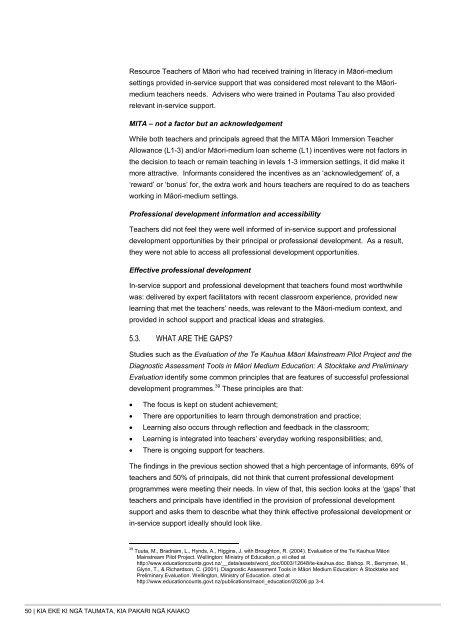Kia eke ki ngÄ Taumata, kia Pakari ngÄ Kaiako He ... - Te Puni Kokiri
Kia eke ki ngÄ Taumata, kia Pakari ngÄ Kaiako He ... - Te Puni Kokiri
Kia eke ki ngÄ Taumata, kia Pakari ngÄ Kaiako He ... - Te Puni Kokiri
You also want an ePaper? Increase the reach of your titles
YUMPU automatically turns print PDFs into web optimized ePapers that Google loves.
Resource <strong>Te</strong>achers of Māori who had received training in literacy in Māori-mediumsettings provided in-service support that was considered most relevant to the Māorimediumteachers needs. Advisers who were trained in Poutama Tau also providedrelevant in-service support.MITA – not a factor but an acknowledgementWhile both teachers and principals agreed that the MITA Māori Immersion <strong>Te</strong>acherAllowance (L1-3) and/or Māori-medium loan scheme (L1) incentives were not factors inthe decision to teach or remain teaching in levels 1-3 immersion settings, it did make itmore attractive. Informants considered the incentives as an ‘acknowledgement’ of, a‘reward’ or ‘bonus’ for, the extra work and hours teachers are required to do as teacherswor<strong>ki</strong>ng in Māori-medium settings.Professional development information and accessibility<strong>Te</strong>achers did not feel they were well informed of in-service support and professionaldevelopment opportunities by their principal or professional development. As a result,they were not able to access all professional development opportunities.Effective professional developmentIn-service support and professional development that teachers found most worthwhilewas: delivered by expert facilitators with recent classroom experience, provided newlearning that met the teachers’ needs, was relevant to the Māori-medium context, andprovided in school support and practical ideas and strategies.5.3. WHAT ARE THE GAPS?Studies such as the Evaluation of the <strong>Te</strong> Kauhua Māori Mainstream Pilot Project and theDiagnostic Assessment Tools in Māori Medium Education: A Stocktake and PreliminaryEvaluation identify some common principles that are features of successful professionaldevelopment programmes. 39 These principles are that:• The focus is kept on student achievement;• There are opportunities to learn through demonstration and practice;• Learning also occurs through reflection and feedback in the classroom;• Learning is integrated into teachers’ everyday wor<strong>ki</strong>ng responsibilities; and,• There is ongoing support for teachers.The findings in the previous section showed that a high percentage of informants, 69% ofteachers and 50% of principals, did not think that current professional developmentprogrammes were meeting their needs. In view of that, this section looks at the ‘gaps’ thatteachers and principals have identified in the provision of professional developmentsupport and asks them to describe what they think effective professional development orin-service support ideally should look like.39 Tuuta, M., Bradnam, L., Hynds, A., Higgins, J. with Broughton, R. (2004). Evaluation of the <strong>Te</strong> Kauhua MāoriMainstream Pilot Project. Wellington: Ministry of Education, p vii cited athttp://www.educationcounts.govt.nz/__data/assets/word_doc/0003/12648/te-kauhua.doc. Bishop. R., Berryman, M.,Glynn, T., & Richardson, C. (2001). Diagnostic Assessment Tools in Māori Medium Education: A Stocktake andPreliminary Evaluation. Wellington, Ministry of Education. cited athttp://www.educationcounts.govt.nz/publications/maori_education/20206 pp 3-4.50 | KIA EKE KI NGĀ TAUMATA, KIA PAKARI NGĀ KAIAKO
















